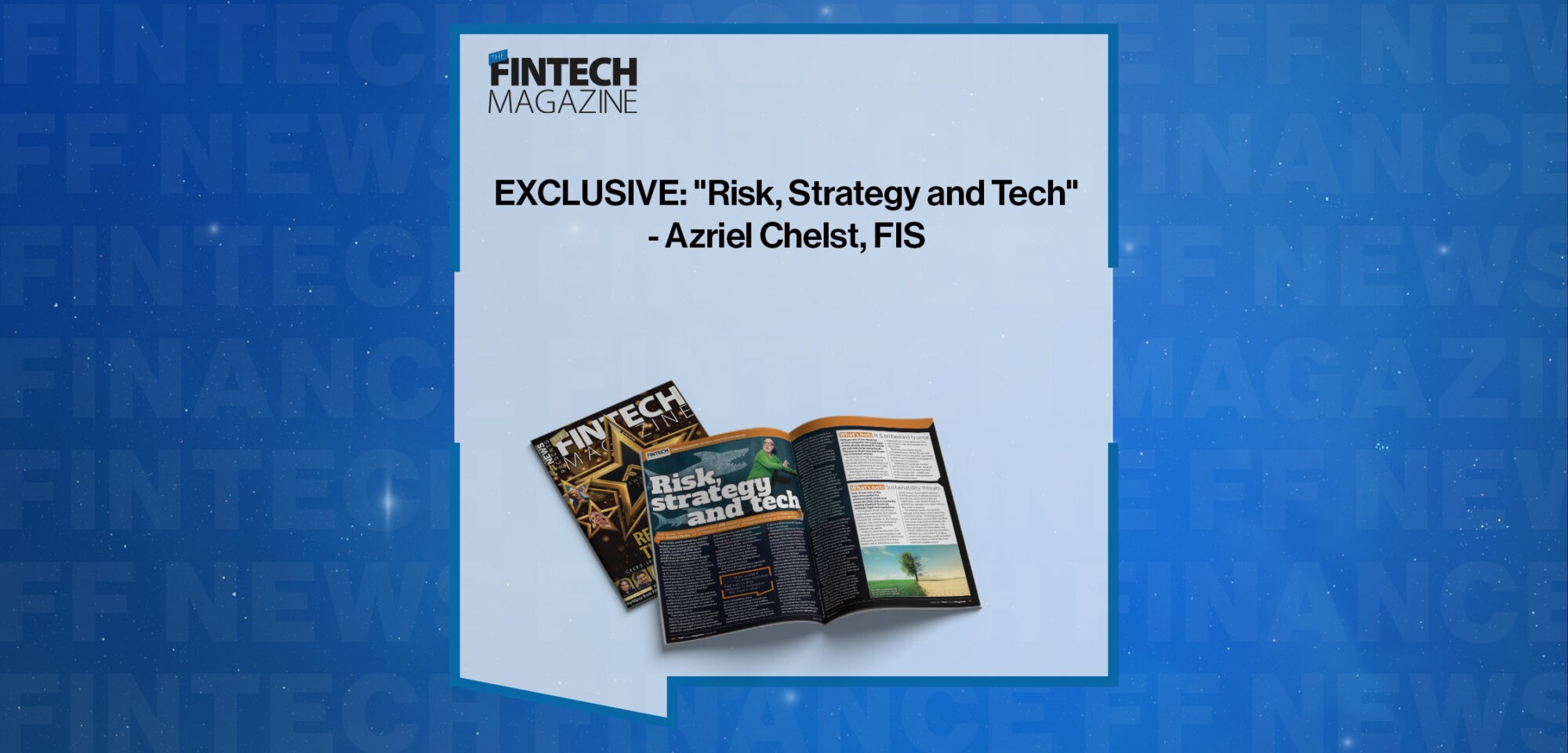Breaking News

EXCLUSIVE: “Risk, Strategy and Tech” – Azriel Chelst, FIS in ‘The Fintech Magazine’
The Global Innovation Report from FIS shines a spotlight on attitudes to threats and tech. Azriel Chelst, VP of Venture Investments, comments on some of the key findings
If in 2020 you’d asked the world’s leading risk analysts what factors would most impact global stability in 2023, you’d probably have a large number of unrealised predictions today that those professionals would rather forget.
To say a lot has happened in the last few years is an understatement. Often, a new business-imperilling crisis has sprung up to challenge the status quo before the impacts of the previous shock have been fully understood. An era-defining global pandemic has been followed by runaway worldwide inflation, the return of hand-to-hand combat between nations on the European mainland and the spectre of a new Cold War.
In this unpredictable and risk-rich new reality, businesses are often hard-pressed to effectively avoid damage, let alone strengthen profit margins. So what are they most concerned about and how are they dealing with it?
That’s what the Global Innovation Report: Creating Advantage In Uncertainty from FIS set out to discover. The authors polled 2,000 leading senior decisionmakers across eight countries and eight industries, creating a detailed view of how they perceive the new risk environment and what their strategies are for managing it, including using innovation and new technologies as solutions.
“I’d be scared if not every executive had told us they believed in innovation – the issue is what?”
A whopping 49 per cent of business leaders surveyed believe their organisation faces more risk than at any time in the past. Retail and fintech companies registered the highest state of risk, polling 60 and 56 per cent respectively. In almost all organisations surveyed, financial and strategic risk were the most compelling areas for concern, including interest rate fluctuation and supply and staffing shortages, and increasingly competitive and fragmented markets.
Fifty-five per cent of respondents concerned about financial risk claim to have been already impacted by it, with 31 per cent of those surveyed expecting to be in the next year. But despite troubled times, 93 per cent of all businesses surveyed are confident that they will be able to overcome the challenges.
And a massive 98 per cent of firms believe innovation plays a role in mitigating macro risks. Fintechs cite innovation in two areas – technology and systems and customer experience – as their primary strategies.
“What we were trying to do with the report is make sure we understood the right way forward through innovation, and the fears behind executing around it,” says Azriel Chelst, who runs direct investments inside FIS Ventures. “Ultimately, what everybody is scared about, when it comes to adopting new technologies, is whether it will increase the volume of work. When you have a system that involves alerts, for example, having a technology tell you something is wrong, and having nobody to execute on it, is not a fun place to be.
“Everybody has to figure out how to balance innovation and risk. Once a computer, or AI, is doing something for you, do you have the right guardrails? Is it doing things the way it should? Is it meeting all the regulatory requirements?
“I’d be scared if not every executive had told us they believed in innovation,” Chelst laughs. “The issue is what? Technology innovation, system innovation, business model innovation, AI, GenAI…? We really tried to slice and dice the data and what came across was that technology and system innovation was the priority.
“Executives know their technology stack can be better, but they’ve also got some systems and processes – whether it’s an organisation of 10 or 10,000 – which are broken, some of which can be done better and faster. So they’re also looking towards innovation there to see how they can improve them. This report is meant to clarify and confirm how investing in innovation and technology can help executives mitigate many types of risk.”
It found that financial institutions, investment and fintech companies were more likely than the rest to reach for technology to solve a challenge. And that gave them a marked degree of extra confidence.
Early technology adopters in particular thought they faced less risk than in the past – a 20 per cent confidence rate compared to 16 per cent across the rest of the businesses surveyed, with 60 per cent of executives identifying as early adopters rating themselves as ‘very confident’ in managing risk effectively, versus the rest at 44 per cent.
Many companies seem to be doubling down on this innovation-led approach. Around two-thirds of existing tech adopters plan to increase their technology spend in the next 12 months, with digital tech for the customer experience and AI the top targets (69 and 68 per cent). And across all sectors, AI/GenAI-focussed solutions were top of the executive shopping list.
The study shows almost universal consensus on what innovation brings to businesses that embrace it. Almost all of those surveyed said it helped them maintain a competitive edge. Improving internal culture was the least compelling reason to innovate. But that’s a missed opportunity, observes Chelst
“We used to think, ‘do we really have to build good technology for employees? Can’t they just figure it out?’ You know, ‘if it looks like Windows 3.1, that’s fine, they’ll just do it’. But the truth is, there’s a new kind of employee base that doesn’t want to suffer old solutions. They want technology that feels like the thing that you put on your iPhone, or Android. They want solutions that feel good, easy, that act sensibly.
“The potential for enhanced efficiency, personalised experience and sustainability is immense”
“In the old days, technology wasn’t very sensible, because you just tried to solve for the greatest audience. Now, we’re looking at how you improve the process flow, because, when you do those things, employees are happier, they work faster, they love their job, they really do want to be part of the solution. And that’s really where AI and technology help – on that system innovation side.”
The FIS team has created a detailed six-part guide to implementing a strategy that circumvents uncertainty and turns innovation into advantage. The first recommended step is to conduct a thorough analysis to determine the short- and long-term risks to a business. The next is to identify which innovation strategies can most effectively mitigate risk to technology infrastructure, business model and customer experience.
Next, business leaders must build an understanding of how the latest tech can support their innovation strategy and how it can be leveraged to help achieve business goals. They need to understand where resistance to innovation is coming from, whether it’s educational, operational or budgetary (the last of which was cited by more than 50 per cent of respondents to the report).
Then they need to map where internal knowledge and skills must be augmented – whether this involves training existing staff, new employees or partnering with an expert.
Finally, customer input must guide decision-making as a client-centric strategy is the most effective path to success. With such an approach in place, John Avery, VP of enterprise strategy at FIS, believes embracing emerging technologies could revolutionise the business world.
“The potential for enhanced efficiency, personalised experience and sustainability is immense,” he says. “These technologies are also important levers for mitigating a variety of risks – making them critical to fostering trust and long-term growth.”
What’s hot: AI & embedded finance
Forty per cent of non-financial services companies surveyed claim to have already adopted AI, and 36 per cent claim to be using GenAI. That rises to 48 per cent and 44 per cent in financial services.
But those figures might be misleading, says FIS’s Azriel Chelst.
“It’s interesting how people think about these things. Is all of their AI just decisioning, or was it really generating content, which is GenAI?” If the figures in fact indicate a broad lack of understanding of what GenAI is, then executives are also likely to underestimate its true potential.
“That was certainly a big ‘aha moment’ for us,” adds Chelst.
There was more clarity around embedded finance. Ninety-five per cent of financial services executives were using or plan to use embedded technologies in the next one to three years.
“Embedded finance was number one for fintechs,” says Chelst, “because it’s an opportunity to move forward on the revenue side – maybe even on the margin side – and go beyond the transaction layer.”
What’s not: Sustainability threats
Only 37 per cent of the executives polled list environmental, social and corporate (ESG) risk as a priority, ranking it behind financial, strategic, legal and regulatory.
This is despite 49 per cent of these organisations saying they have already felt the impact of environmental transition risk. Changes on the horizon, however, may cause this package of threats to start rocketing up the corporate risk agenda.
In the US, incoming Securities and Exchange Commission regulation will soon force all companies to report their ESG scores, an initiative that many believe will be adopted around the world. Indeed, there’s good evidence that ESG pressure is already coming to bear on executives from corporate stakeholders, with Stanford Business publishing a detailed new report on how this works in practice.
For Stephen Vitoria, Climate Risk Manager at FIS, this is potentially a big innovation driver. “Increasing pressure from stakeholders around ESG is guiding how many organisations prioritise risks and pursue innovation,” he says. ”The financial impact of sustainability and climate-related risks and opportunities… will likely spur investment in product, service and operating model innovation, as these are likely to deliver the most visible and tangible results.”
Startup risk: Will they survive the great ‘mass extinction’?
“Macro risks are really crushing the startups,” says Azriel Chelst, VP of venture investments at FIS. “At the end of the day, they raised money with expectations that it would last them a certain amount of time and that, later on in the process, they would raise again.
Unfortunately, with interest rates and access to credit where they are, they can’t do that. So now they’re just… bleeding.“
This isn’t an isolated view.
In February, Investment Monitor predicted 2023 would be the biggest ‘startup mass extinction’ event since 2008, with 81 per cent of early-stage startups telling it they had less than 12 months of runway left.
Investment Monitor cited Globaldata statistics which showed the scale of plummeting global venture financing throughout 2022. It said the value of global VC had dropped 36 per cent in 2022 – from $512.7billion in 2021 to $293.8billion.
This trend can also be seen at a more granular level, with startup deals dropping nine per cent in the fourth quarter of 2022 and growth-stage deals experiencing an even bigger, 24 per cent drop in deal volume.
Has there been any cause for optimism since then?
Well, a recent Crunch.co.uk report says that, despite a challenging year, startups have displayed ‘remarkable resilience’, adapting to a new peril-filled environment with innovative solutions and agile strategies, even in the face of a cautious funding cycle.
“What we’re seeing is that about a third of startups are trying to just make it work,” says Chelst. “They’re trying to improve their margins, they’re trying to reduce burn, and really focussing on new ways to streamline the processes – it’s about automation, automation, automation. You can throw that after every word, treasury automation, AP automation, AR automation.”
Of all the businesses affected by existential threats, it’s this cohort of young companies which is the most vulnerable, he says, but it is also the most determined and capable of using technology to outpace the threats.
“We’ve met startups who had launched solutions in Ukraine, for instance, and had 20 banks behind them as customers, and as soon as the war broke out, they were stuck. So then what did they do? Some have come over to the US or Canada and they do their best to just take the technology that they’ve built, and port it over to a new customer base.
“There are amazing founders, who have used this as an opportunity to reset their strategy, but, ultimately, deliver great solutions.
“At FIS, we understand the pains, the challenges they go through, and we want to try to do our best to help them.”
This article was published in The Fintech Magazine Issue 30, Page 40-42
People In This Post
Companies In This Post
- How USAA Builds Digital Experiences Around Its Members Read more
- Spayce: Organic Growth, Own Tech, New Wallet Read more
- EXCLUSIVE: “Check, Check… and Check!” – Pilar Fragalà, CBI in ‘The Fintech Magazine’ Read more
- BBVA: Digital Identity Will Transform KYC Read more
- Pocket Network Is Pioneering ‘DePIN for Data’ Read more

















